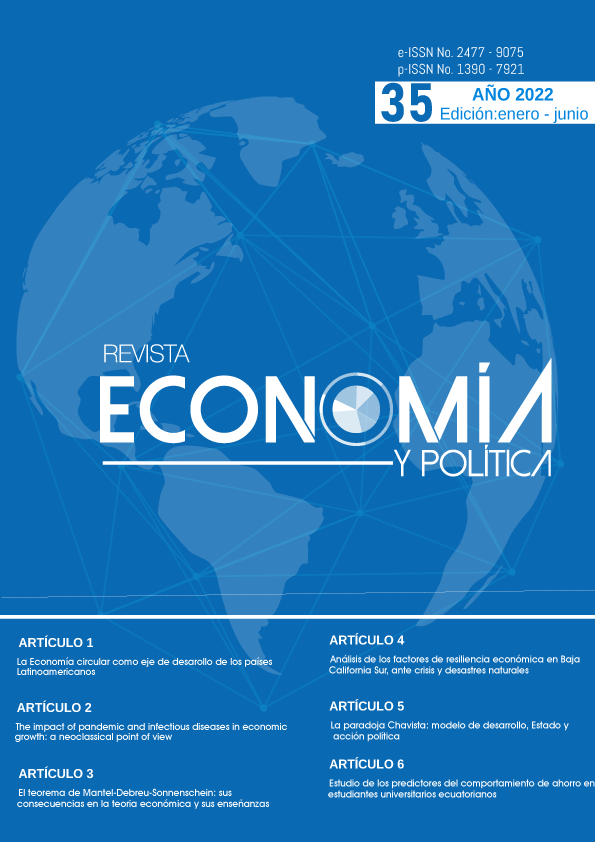Estudio de los predictores del comportamiento de ahorro en estudiantes universitarios ecuatorianos
DOI:
https://doi.org/10.25097/rep.n35.2022.06Palabras clave:
ahorro, comportamiento de ahorro, predictores, investigación interdisciplinaria, EcuadorResumen
Esta investigación explora, desde una perspectiva interdisciplinaria, los determinantes del comportamiento de ahorro individual en el contexto ecuatoriano. Para ello, se propone un modelo explicativo que integra aportes teóricos producidos desde la economía, la sociología y la psicología. El estudio cuantitativo se basó en una muestra de 1535 estudiantes universitarios de establecimientos públicos y privados de Quito-Ecuador. El modelo de regresión multivariante desarrollado indica que el ingreso familiar predice negativamente el comportamiento de ahorro, mientras que la edad, la escolaridad parental y el género no mostraron efectos significativos. En contraste, la socialización financiera familiar, el altruismo y el alfabetismo financiero se relacionan positivamente con el comportamiento de ahorro. Entre los predictores significativos, el alfabetismo financiero se posicionó como el factor explicativo más relevante del comportamiento de ahorro.
Descargas
Citas
Ameliawati, M., & Setiyani, R. (2018). The influence of financial attitude, financial socialization, and financial experience to financial management behavior with financial literacy as the mediation variable. KnE Social Sciences, 3 (10), 811-832. https://doi.org/10.18502/kss.v3i10.3174
Afsar, J., Chaudhary, G. M., Iqbal, Z., & Aamir, M. (2018). Impact of Financial Literacy and Parental Socialization on the Saving Behavior of University Level Students. Journal of Accounting and Finance in Emerging Economies, 4(2), 133-140. https://doi.org/10.26710/jafee.v4i2.526
Babiarz, P., & Robb, C. A. (2014). Financial literacy and emergency saving. Journal of Family and Economic Issues, 35(1), 40-50. https://doi.org/10.1007/s10834-013-9369-9
Banco Mundial (2017). Global Findex. Recuperado de https://databank.bancomundial.org/source/global-financial-inclusion
BID (2016). Ahorrar para desarrollarse: cómo América Latina y el Caribe puede ahorrar más y mejor. Washington: BID.
Blackburn, R. (2014). El futuro del sistema de pensiones. Madrid: Ediciones Akal.
Cáceres, L. R. (2020). Género y ahorro interno en América Latina. Revista Mexicana de Economía y Finanzas Nueva Época REMEF, 15(3), 414-434. https://doi.org/10.21919/remef.v15i3.515
Castillo, J. C., Miranda, D., & Cabib, I. M. (2013). Todos somos de clase media: Sobre el estatus social subjetivo en Chile. Latin American Research Review, 48 (1), 155-173.
Chang, Y. R. (1994). Saving behavior of US households in the 1980s: Results from the 1983 and 1986 Survey of Consumer Finance. Financial Counseling and Planning, 5(1), 45-64.
Chen, B., Van Assche, J., Vansteenkiste, M., Soenens, B., & Beyers, W. (2015). Does psychological need satisfaction matter when environmental or financial safety are at risk?. Journal of Happiness Studies, 16(3), 745-766. https://doi.org/10.1007/s10902-014-9532-5
Chai, M. T., Chia, Y. K., Fong, S. N., Lew, W. C., & Tan, C. T. (2011). Determinants of saving behaviour among the university students in Malaysia (Doctoral dissertation). Malaysia: UTAR.
Cho, S. H., Gutter, M., Kim, J., & Mauldin, T. (2012). The effect of socialization and information source on financial management behaviors among low‐and moderate‐income adults. Family and Consumer Sciences Research Journal, 40(4), 417-430. https://doi.org/10.1111/j.1552-3934.2012.02120.x
Chowa, G. A., Masa, R. D., & Ansong, D. (2012). Determinants of saving among low-income individuals in rural Uganda: evidence from assets Africa. Advances in Applied Sociology, 2(04), 280-291. http://dx.doi.org/10.4236/aasoci.2012.24037
Copur, Z., & Gutter, M. S. (2019). Economic, sociological, and psychological factors of the saving behavior: Turkey case. Journal of Family and Economic Issues, 40(2), 305-322. https://doi.org/10.1007/s10834-018-09606-y
De Bassa Scheresberg, C. (2013). Financial literacy and financial behavior among young adults: evidence and implications. Numeracy, 6(2), 1-21. http://dx.doi.org/10.5038/1936-4660.6.2.5
Denegri Coria, M., Martínez Toro, G., & Etchebarne López, S. (2007). La comprensión del funcionamiento bancario en adolescentes chilenos: un estudio de psicología económica. Interdisciplinaria, 24(2), 137-159.
Falahati, L., & Paim, L. H. (2011). Toward a framework of determinants of financial management and financial problems among university students. African Journal of Business Management, 5(22), 9600-9606. https://doi.org/10.5897/AJBM.9000654
Fatoki, O., & Oni, O. (2014). Financial literacy studies in South Africa: Current literature and research opportunities. Mediterranean Journal of Social Sciences, 5(20), 409-414. https://doi.org/10.5901/mjss.2014.v5n20p409
Fisher, P. J. (2010). Gender differences in personal saving behaviors. Journal of Financial Counseling and Planning, 21(1), 14-24.
Friedman, M. (1957). A Theory of the Consumption Function. Cambridge: National Bureau of Economic Research.
Furnham, A. (1999). The saving and spending habits of young people. Journal of Economic Psychology, 20(6), 677-697. https://doi.org/10.1016/S0167-4870(99)00030-6
Garay Anaya, G. (2015). Las finanzas conductuales, el alfabetismo financiero y su impacto en la toma de decisiones financieras, el bienestar económico y la felicidad. Revista Perspectivas, (36), 7-34. https://doi.org/10.29057/icea.v7i13.3508
Garcia Bianchi, A., Santillán Leiba, R., & Sotomayor Valenzuela, N. (2020). Determinantes del Ahorro Voluntario en el Perú: Evidencia de una Encuesta de Demanda. Perú: Superintendencia de Banca, Seguros y Administradoras Privadas de Fondos de Pensiones.
González Jaramillo, V. H., Sabando-Vera, D., Amaya Peso, C., & Noboa Panchana, J. (2018). Propuesta de sustentabilidad para el fondo del Instituto Ecuatoriano de Seguridad Social (IESS). Revista Espacios, 39 (07).
Gutter, M. S., Hayhoe, C., & DeVaney, S. (2008). Economic and psychological determinants of savings behavior: A conceptual model. En Consumer interests annual, vol. 54. Annual ACCI Conferences, Estados Unidos
Hira, T. K., & Loibl, C. (2005). Understanding the impact of employer‐provided financial education on workplace satisfaction. Journal of Consumer Affairs, 39(1), 173-194. https://doi.org/10.1111/j.1745-6606.2005.00008.x
Horioka, C. Y., Fujisaki, H., Watanabe, W., & Kouno, T. (2000). Are Americans more altruistic than the Japanese? A US-Japan comparison of saving and bequest motives. International Economic Journal, 14(1), 1-31. https://doi.org/10.1080/10168730000000001
Jacobs-Lawson, J. M., Hershey, D. A., & Neukam, K. A. (2004). Gender differences in factors that influence time spent planning for retirement. Journal of Women & Aging, 16(3-4), 55-69. https://doi.org/10.1300/J074v16n03_05
Jamal, A. A. A., Ramlan, W. K., Karim, M. A., & Osman, Z. (2015). The effects of social influence and financial literacy on savings behavior: A study on students of higher learning institutions in Kota Kinabalu, Sabah. International Journal of Business and Social Science, 6(11), 110-119.
Keynes, J. M. (1936). Teoría general de la ocupación, el interés y el dinero. México: Fondo de Cultura Económica.
Kim, J., Spangler, T. L., & Gutter, M. S. (2016). Extended families: Support, socialization, and stress. Family and Consumer Sciences Research Journal, 45(1), 104-118. https://doi.org/10.1111/fcsr.12187
Leitch, D., Sánchez, R., & Villena, M. (2020). Sistemas de pensiones en el mundo: Lecciones para Chile. Puntos de Referencia, (556), 1-27.
Levine, P.B., Mitchell, O.S., & Moore, J.F. (2000). Women on the Verge of Retirement: Predictors of Retiree Wellbeing. En O.S. Mitchell, P.B. Hammond, & A.M. Rappaport. (Eds.), Forecasting retirement needs and retirement wealth (pp.167-207). Philadelphia: University of Pennsylvania Press.
Loayza, N., Schmidt-Hebbel, K., & Servén, L. (2001). Una revisión del comportamiento y de los determinantes del ahorro en el mundo. Chile: Banco Central de Chile.
Lusardi, A. (2008). Household Saving Behavior: The Role of Financial Literacy, Information, and Financial Education Programs. NBER Working Paper 13824. Estados Unidos: National Bureau of Economic Research.
Lusardi, A., & Mitchell, O. S. (2014). The economic importance of financial literacy: Theory and evidence. Journal of economic literature, 52(1), 5-44. https://doi.org/10.1257/jel.52.1.5
Lusardi, A., & Mitchell, O. S. (2007). Financial literacy and retirement preparedness: Evidence and implications for financial education. Business economics, 42(1), 35-44. https://doi.org/10.2145/20070104
Lusardi, A., Mitchell, O. S., & Curto, V. (2010). Financial literacy among the young. Journal of consumer affairs, 44(2), 358-380. https://doi.org/10.1111/j.1745-6606.2010.01173.x
Mahdzan, N.S., & Tabiani, S. (2013). The Impact of Financial Literacy on Individual Saving: an Exploratory Study in the Malaysian Context. Transformations in Business & Economics, 12 (1), 41-55.
Marshall, G. L., Kahana, E., Gallo, W. T., Stansbury, K. L., & Thielke, S. (2020). The price of mental well-being in later life: the role of financial hardship and debt. Aging & Mental Health, 25 (7), 1338-1344. https://doi.org/10.1080/13607863.2020.1758902
Modigliani, F., & Brumberg, R. (1954). Utility analysis and the consumption function: An interpretation of cross-section data. Franco Modigliani, 1(1), 388-436.
Montilla Jiménez, G., Aranda López, M., & Montes Berges, B. (2009). Evaluación de la Empatía, Experiencia Espiritual y Altruismo. Adaptación y Validación al Español. Iniciación a la Investigación, (4).
Ningsih, R. S., Widiyanto, W., & Sudarma, K. (2018). The Effect of Family Environment and School Environment Towards Savings Behavior Through Self Control in High School Students in Purwodadi City, Grobogan Regency. Journal of Economic Education, 7(1), 52-59.
Nordblom, K. (2004). Cohabitation and marriage in a risky world. Review of Economics of the Household, 2(3), 325-340. https://doi.org/10.1007/s11150-004-5650-x
Nordblom, K. (1997). Precautionary Saving and Altruism. Working Paper, No. 1997:19. Uppsala: Uppsala University, Department of Economics.
Peng, T. C. M., Bartholomae, S., Fox, J. J., & Cravener, G. (2007). The impact of personal finance education delivered in high school and college courses. Journal of family and economic issues, 28(2), 265-284. https://doi.org/10.1007/s10834-007-9058-7
Pew Research Center (2009). Majority of Americans Say Parents are Doing Too Much for Their Young Adult Children. Estados Unidos: The Pew Charitable Trusts.
Perry, V. G., & Morris, M. D. (2005). Who is in control? The role of self‐perception, knowledge, and income in explaining consumer financial behavior. Journal of consumer affairs, 39(2), 299-313. https://doi.org/10.1111/j.1745-6606.2005.00016.x
Ramírez Marrero, M. C. (2021). El Desafío de una Alfabetización Financiera. Business Innova Sciences, 2(1), 67-75.
Remble, A. A., Marshall, M. I., & Keeney, R. (2014). Household saving behavior and the influence of family-owned business. Journal of Family and Economic Issues, 35(3), 411-422. https://doi.org/10.1007/s10834-013-9372-1
Rodríguez, E., & Sandoval-Escobar, M. C. (2018). Prácticas de ahorro de las familias bogotanas: relación entre factores socioculturales, psicológicos y económicos. En D. Forero. (Ed.), Elección, Razonamiento y Decisión (pp. 52-75). Bogotá: Fundación Universitaria Konrad Lorenz.
Roy Morgan Research (2003). ANZ Survey of Adult Financial Literacy in Australia: Final Report, Melbourne: ANZ Bank.
Sabri, M. F., & MacDonald, M. (2010). Savings behavior and financial problems among college students: The role of financial literacy in Malaysia. Cross-Cultural Communication, 6(3), 103-110. http://dx.doi.org/10.3968/j.ccc.1923670020100603.009
Sabri, M. F., Mokhtar, N., Ho, C. S., Anthony, M., & Wijekoon, R. (2020). Effects of gender and income on Malaysian’s financial capability. Malaysian Journal of Consumer and Family Economics, 24, 124-152.
Soriano, D. (2019). Las finanzas de los 'millennials': sin ahorros, sin formación y más dependientes de sus padres. Recuperado el 25 de marzo de 2021, de: https://bit.ly/3m2w9sw
Stango, V., & Zinman, J. (2007). Fuzzy math and red ink: When the opportunity cost of consumption is not what it seems. Estados Unidos: Dartmouth College, Working Paper.
Sunden, A. E., & Surette, B. J. (1998). Gender differences in the allocation of assets in retirement savings plans. The American Economic Review, 88(2), 207-211.
Whitaker, E. A., Bokemeiner, J. L., & Loveridge, S. (2013). Interactional associations of gender on savings behavior: Showing gender’s continued influence on economic action. Journal of Family and Economic Issues, 34(1), 105-119. https://doi.org/10.1007/s10834-012-9307-2
Zhao, H., & Zhang, L. (2020). Talking money at home: the value of family financial socialization. International Journal of Bank Marketing, 38 (7), 1617-1634. https://doi.org/10.1108/IJBM-04-2020-0174
Zumárraga-Espinosa, M., & Cevallos-Pozo, G. (2021). Evaluación psicométrica de la Escala de Procrastinación Académica (EPA) y la Escala de Resiliencia Académica (ARS-30) en personas universitarias de Quito-Ecuador. Revista Educación, 45(1), 363-384. https://doi.org/10.15517/REVEDU.V45I1.42820
Publicado
Cómo citar
Número
Sección
Licencia
Derechos de autor 2022 Revista Economía y Política

Esta obra está bajo una licencia internacional Creative Commons Atribución-NoComercial-CompartirIgual 4.0.






